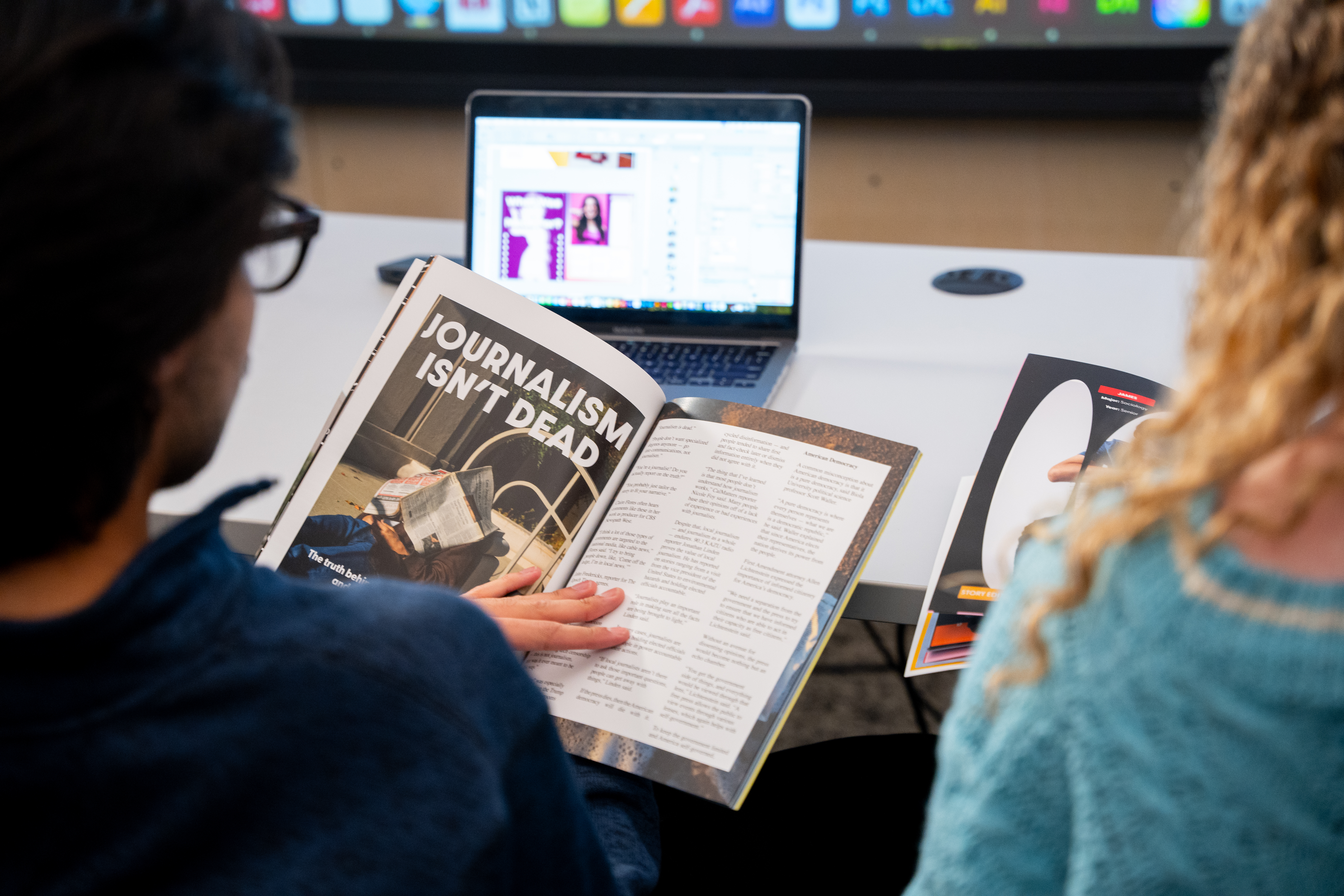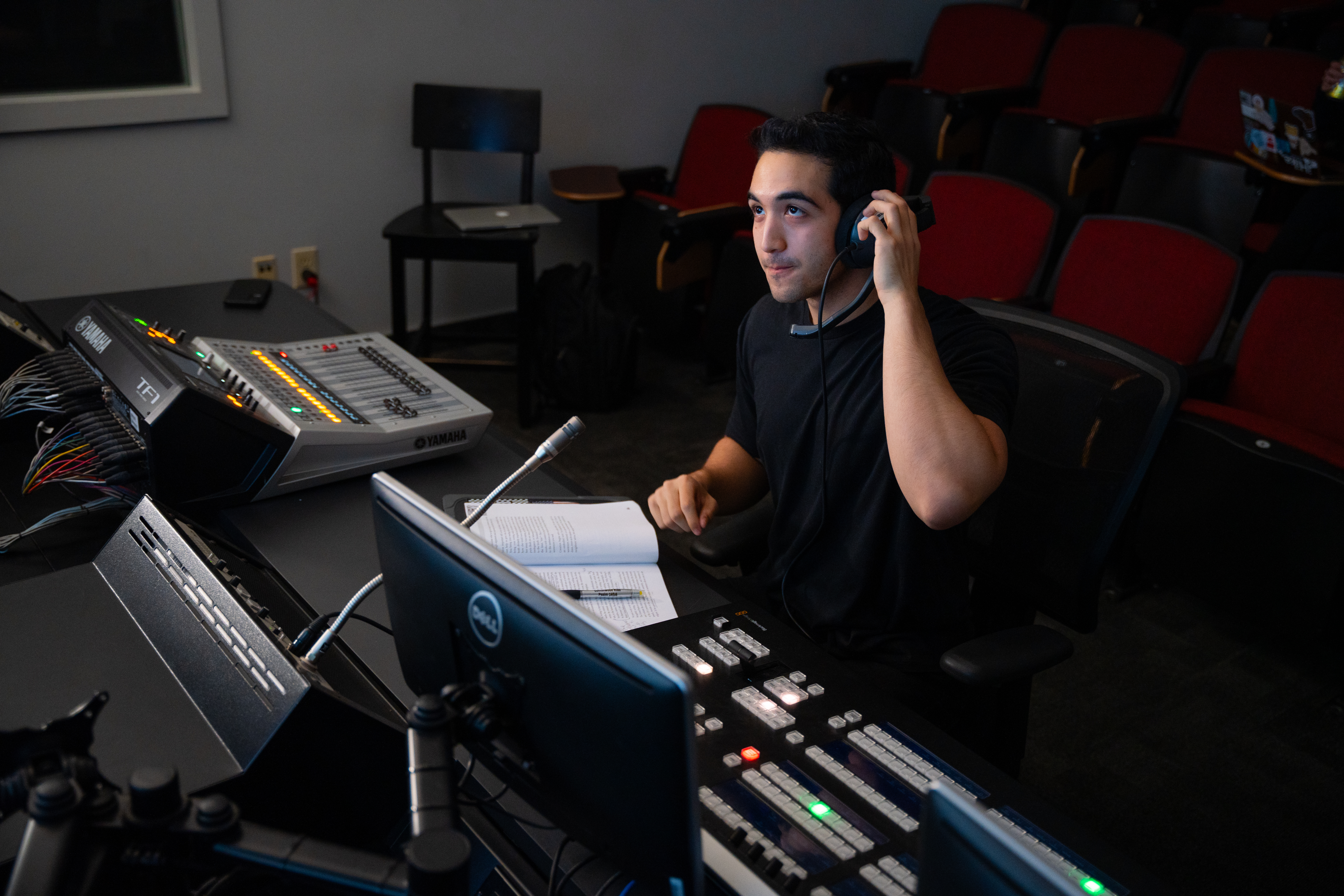
Biola journalism students working on The Chimes newspaper. (Photos provided by David Baxter.)
By Alexa Lewis
Near Hollywood, California, there are many reporting operations working to cover local culture, politics, and celebrities. Among the most prolific reporting operations is not a newsroom at all, but a collection of students working out of Biola University.
With an array of journalism classes, publication opportunities, and student-run media organizations, Biola University has many avenues to help students get involved in reporting on the campus community and the vibrant cities beyond.
 Students can choose to get involved in print, digital, and broadcast journalism through an array of campus organizations. The school is home to a long-running student newspaper, a digital daily news operation, several magazines, and broadcast programs. Biola’s features magazine, called The Point, is run entirely by students, and offers professional skill-building in news writing, editorial work, photography, and graphic design. In the university’s Multimedia Narrative Project class, students engage in in-depth documentary reporting that explores cross-cultural themes such as how Asian culture comes to be viewed through the lens of food. This work is compiled in a book that is published by the university press, Biola Avenue Press.
Students can choose to get involved in print, digital, and broadcast journalism through an array of campus organizations. The school is home to a long-running student newspaper, a digital daily news operation, several magazines, and broadcast programs. Biola’s features magazine, called The Point, is run entirely by students, and offers professional skill-building in news writing, editorial work, photography, and graphic design. In the university’s Multimedia Narrative Project class, students engage in in-depth documentary reporting that explores cross-cultural themes such as how Asian culture comes to be viewed through the lens of food. This work is compiled in a book that is published by the university press, Biola Avenue Press.
On the broadcast side, students have opportunities in television and radio-based media production. Every fall semester, Biola puts out a newscast called EagleVision on YouTube. EagleVision follows a traditional newscasting format, with two anchors and news packages that students have shot across Los Angeles. In the spring, students put out a morning talk show called Good Morning Biola which often includes news packages as well. Biola’s student radio station has long been a fixture of campus culture, and is currently focusing on moving towards podcast production to sustain interest and engagement.
“The interest is in trying to give students a voice they didn’t have before,” said Michael Longinow, chair of Biola’s Department of Digital Journalism and Media. “There’s diminishing interest among students to pick up the traditional newspaper. We want to give students new ways to find out about the things impacting their campus and their world.”
 Longinow— who advises one of Biola’s student-run newspapers called The Chimes and currently teaches a Multimedia Reporting class—has been working on the expansion of student journalism at the university. He not only wishes to make quality reporting available to Biola’s student body, but to help students’ reporting skills evolve with the changing media landscape.
Longinow— who advises one of Biola’s student-run newspapers called The Chimes and currently teaches a Multimedia Reporting class—has been working on the expansion of student journalism at the university. He not only wishes to make quality reporting available to Biola’s student body, but to help students’ reporting skills evolve with the changing media landscape.
“We’re finding that some of the more forward-thinking media groups are turning Instagram into a place where news is being delivered in a way that appeals to more viewers,” Longinow said. “It involves very tight writing, very media-heavy clips with lots of photo and video, and taking angles that mainstream news might not be exploring.”
In Longinow’s Multimedia Reporting class, students are each assigned to a different city, and tasked with filling gaps in community reporting. Student reporters immerse themselves in these communities, attending public meetings, hearings, and events. Students have succeeded pitching stories from the class to local news outlets, which often struggle to cover everything within their area of coverage due to dwindling resources.
“There are news deserts everywhere. As journalism is finding new ways to repurpose itself to stay relevant, there are gaps left behind where stories aren’t being told,” Longinow said. “[This class] is an opportunity for students to step into a community and cover things that often aren’t getting the attention they need. Some of our students have gone from this class to become professional community reporters after graduation.”
As Biola’s student-driven journalism outlets continue to develop new ways to engage audiences, podcasting and data-driven reporting have become growing areas of interest. Print and digital reporting students have been learning how to produce visualizations of complex data that are easily digestible for viewers. Students interested in audio reporting have been moving away from real-time radio reporting, and working on developing more in-depth, polished stories in a podcast format.
“Podcasting can just be so powerful,” Longinow said. “Students don’t always realize how impactful a voice and audio effects can be. It sticks with people and can be very compelling.”
In-text image caption: Biola students producing journalism packages for broadcast. (Photos provided by David Baxter.)
In-text image caption: Biola students putting together campus magazines. (Photos provided by David Baxter.)
